In many styles of Kung Fu, in addition to empty hand combat techniques, different kinds of weapon techniques are practiced. These weapons include, on the one hand, military weapons formerly used in the regular army, such as sabers and halberds; on the other hand, non-military weapons such as sticks, knives, daggers, whips, etc. and, finally, a series of everyday objects that, if necessary, can be used in combat. The arsenal of Choy Li Fut 蔡李佛 is especially profuse in this type of objects. We are talking about, among others, the fan, the bench, the cane or crutch, the hoe, the flute...
These objects can be, and were often, used in street clashes both to defend oneself and to attack. Learning to fight using an everyday object aims to be able to defend oneself with anything at hand; any kind of object can become an improvised weapon.
Today, and especially in the West, we will rarely have a Chinese-style fan or bench on hand; however, if we know how to use these weapons we can extrapolate the techniques to any other object of similar characteristics that we have at our fingertips. It is even possible that these objects are more effective in combat than those with whom the training has been performed since, in many cases, the choice of such an object to be included in a training routine responds more to an impulse of romanticism than to a deep analysis of its martial effectiveness.
Let's review some of these items often used as weapons:
The fan
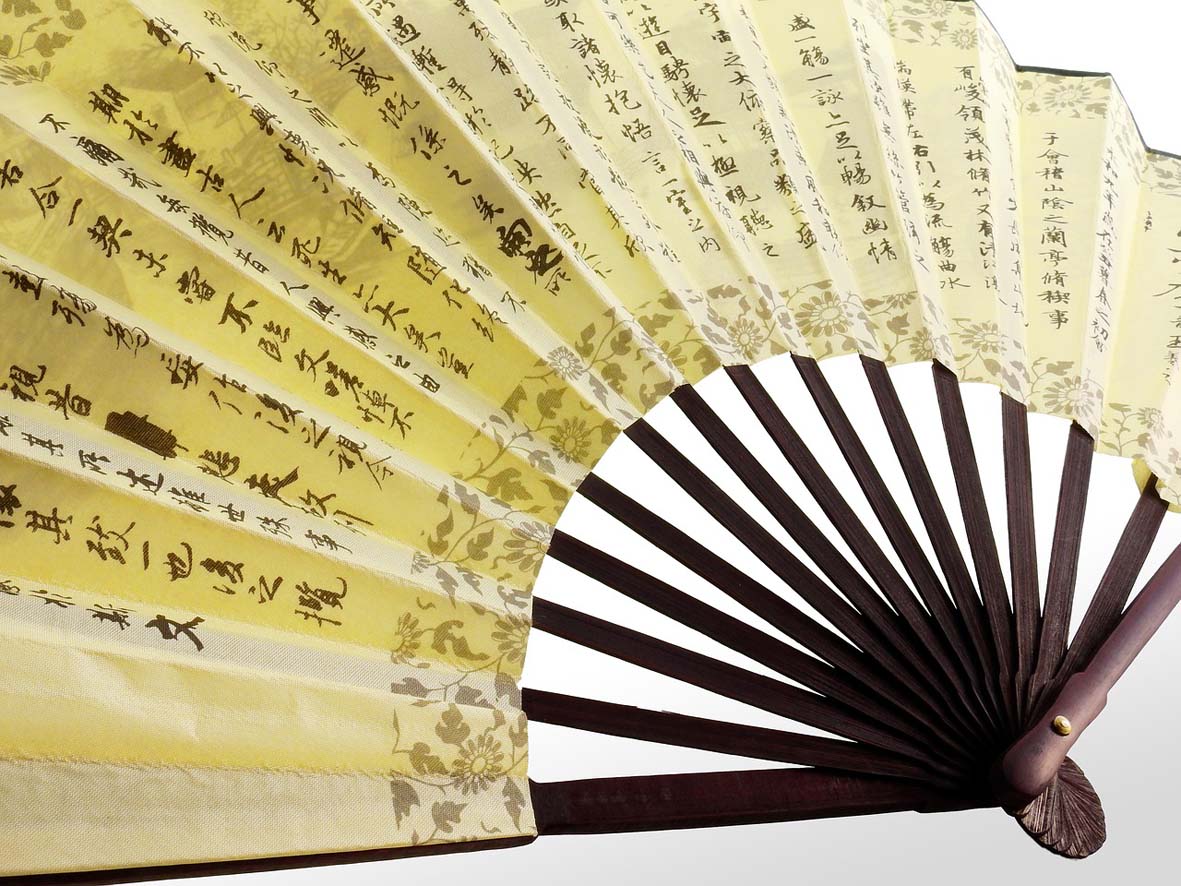 This is without a doubt one of the most widely used traditional weapons, as almost all styles include fan training forms. Used in ancient China by both women and men, it was one of the most common objects on hand. Fan combat techniques are similar to those used with a short stick or other similarlypaned object, and include mainly hitting and nailing. Because the fan is a light object, the techniques are mainly directed to weak spots of the body, such as the temple, throat, wrist or groin, and are performed with the fan closed. Currently there are many fan forms that also include techniques with the fan opened. However, these are always "flowery" and showy techniques, used to attract the public's attention, and of little martial effectiveness.
This is without a doubt one of the most widely used traditional weapons, as almost all styles include fan training forms. Used in ancient China by both women and men, it was one of the most common objects on hand. Fan combat techniques are similar to those used with a short stick or other similarlypaned object, and include mainly hitting and nailing. Because the fan is a light object, the techniques are mainly directed to weak spots of the body, such as the temple, throat, wrist or groin, and are performed with the fan closed. Currently there are many fan forms that also include techniques with the fan opened. However, these are always "flowery" and showy techniques, used to attract the public's attention, and of little martial effectiveness.
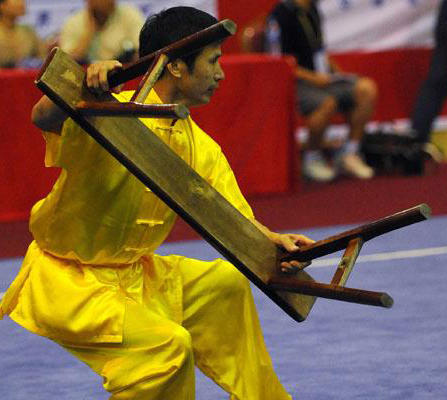
The bench
The Chinese bench consists of an long seat, without backrest, and four legs that point slightly out obliquely outwards, all in solid wood. The bench is a heavy object that needs some physical strength to handle, although power must be generated from the coordinated movement of the body and not from brute force. The Chinese bench can be replaced by any chair we have at our fingertips, and is especially useful for defending against sharp short weapons, such as knives, as the legs of the chair offer a safe distance to hit with them, and the stool acts as a shield.

The bamboo flute
The flute is simply a short, small-sized stick. Its techniques are similar to those of the fan, although their range is a bit longer. Having little weight, it will be directed mainly at vital points, using percussing or thrusting blows.
Another everyday object to which we can apply flute techniques is a newspaper, rolled in the shape of a tube.
The spade
We've already talked about the Monk's Spade in another article. This weapon derives from the shovel used as a tool for digging. Spade techniques can be extrapolated to other similar tools.
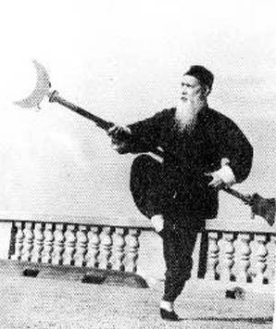
The farmer's hoe
Choy Li Fut was born at the time of the anti-Manchu revolution. The first masters taught the peasant population, who lacked military weapons, to defend themselves with what they had at hand. In this way, the hoe was one of the most common tools used by militias as a combat weapon. The hoe is a long, heavy, sharped tool, that can hook and pull the opponent's weapon to disarm him, as well as cause serious injury.
The cane or crutch
The cane or crutch was already one of the traditional weapons in the time of Shàolín 少林. It is without a doubt one of the most versatile weapons, as it allows you to hit hard, nail, catch and twist. Today the umbrella is its most common equivalent.
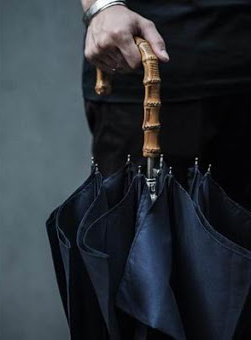
The umbrella
An umbrella is an object commonly used worldwide. In China, in addition to rainy days, it is sometimes used on sunny days to protect from the sun. The umbrella inherits the techniques of the cane but differs in its consistency. The wooden cane is much more robust and allows strikes and blockages with which the umbrella would break. Umbrella strikes almost exclusively use the tip, and their blocks are enveloping rather than frontal, focusing on deflecting rather than stopping the opponent's weapon.
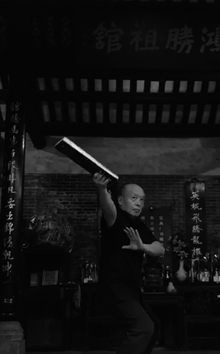
El ábaco
The abacus is undoubtedly one of the most peculiar "weapons". Characteristic of the Hung Sing 鸿胜 branch of Futsan 佛山, it is handled by inserting the fingers between the rods. Although different because of its shape and robustness, it nevertheless finds some parallel with the fan.
Pictured on the left, Master Ho Choek Wa 何焯华 of Futsan Hung Sing Gun 佛山鸿胜馆 demonstrating an abacus technique.
The carrying pole

Another typical weapon of the Hung Sing branch, the carrying pole (biǎn dān 扁担) is a short piece of bamboo cane, cut longitudinally, that has been used in China since ancient times to haul goods. These are placed in baskets that hang from both ends of the pole, which is carried over the shoulders. Its techniques are powerful and similar to those of a medium-length stick.

The towel
Again, belonging to the Hung Sing branch, the towel teaches how to handle a flexible object to hit, trap and twist. Techniques can be extrapolated, similarly to a whip, to any other flexible object, such as a jacket, belt or even a chain.
These are just a few of the many items that Chinese martial arts use as a weapon. Some styles have combat forms with other objects, even with an opium pipe. We must remember that the important thing is to learn to extrapolate these kinds of techniques to other similar objects. The more diversity of objects we use in our training, the more resources in our environment we will be able to exploit in case we need to defend ourselves.
